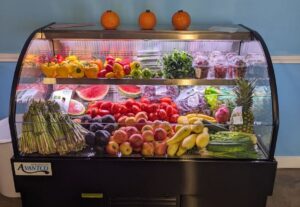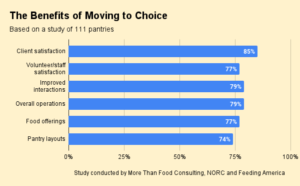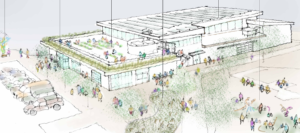The healthy food pantry that Capital Area Food Bank is helping to run at Children’s National Hospital in D.C. is a good example of the type of evolution happening throughout the nation’s food pantry networks.
The pantry, open to young patients with diabetes, aims to eliminate barriers to accessing healthy food by bringing it directly to the people who need it most. Oddly enough, the idea of distributing food in places with the highest need has not always been a top priority for food banks.
“Resources tend to follow the path of least resistance,” noted Bob Shaver, Principal at Redstone Strategy Group, a social impact consultancy, in a recent draft white paper written with Kate MacKenzie, Director of the Mayor’s Office of Food Policy in NYC. “Often, this means new resources flow to larger, better resourced providers that have the capacity to absorb them.”
In practice, this also means that many pantries within a network wind up being located in wealthier areas, supported by well-resourced churches and communities. Clients often must travel outside of their immediate neighborhoods to access those pantries.

Such shortcomings in the way food is distributed were magnified during the pandemic when immigrant and community groups had to rally to feed their underserved neighborhoods. Now food banks are responding, leading to an overall shift in the look and feel of food pantry networks.
“We’re in the process of evolving what our network looks like,” said Radha Muthiah, President and CEO of Capital Area Food Bank, articulating an increasingly common theme among food bankers.
The food bank’s network of about 450 pantry partners dwindled to about 60 during the pandemic, and is now back up to 300 or so. About 30 to 40 of the current partners are new to the network, reflecting a shift both in “who is coming back and who we are choosing to recruit,” Muthiah noted.
In addition to the children’s hospital, newer partners include a federally qualified health center, various community colleges, a Latin American youth center and a workforce development organization. “Almost none of them is just a pantry,” Muthiah said. “None of them in the past would have distributed food.”
She added that Capital Area Food Bank has taken a data-driven approach to broadening its pantry network by segmenting its client base into various archetypes, such as grandparents, students, the houseless, or low-income workers. “That’s allowed us to think about other types of partners we may need to bring into the network to support the participant archetypes,” Muthiah said.
Blue Ridge Area Food Bank, based in rural Virginia, is also on a mission to broaden its agency network. “We realized that marginalized communities were harder hit by the pandemic and would need greater support,” said Michael McKee, CEO. “So we started reaching out to as many different kinds of groups as we could identify, especially immigrant groups because of their lack of access to federal programs.”
Now the food bank has about 23 new types of partners in its network, mostly immigrant-serving organizations, as well as some free and rural clinics and some schools. It’s a step toward diversification at a time when the food bank’s traditional reliance on churches is becoming more tenuous. Contraction among faith-based organizations is accelerating as rural populations age, McKee noted.
McKee wants to expand the food bank’s reach both by seeking out communities of color and immigrants, as well as by adding new forms of partners beyond churches, such as schools, clinics, hospitals and other social service agencies. “We need to diversify our agency network,” he said.
At Tarrant Area Food Bank in Texas, the pandemic has led to permanent changes in the network. Before the pandemic, for example, the food bank ran about 13 mobile pantries a week. Now it runs more than 60. Similarly, it had a few school pantries, and now has about 70.
“We’re seeing a lot of growth in mobile, schools and healthcare clinics,” said Julie Butner, President and CEO, in an interview this spring. She noted, “Usually those facilities are open and reliable. They’re an alternative to what we’ve historically done at churches.”
In their white paper, Shaver and MacKenzie argue that the overall delivery of essential services is undergoing a transformation, now that the pandemic has exposed various weaknesses of traditional approaches. In addition to resources not always flowing to the places of highest need, service delivery tended to be based on limited information about the people being served. Further, providers have historically focused on improving services for existing clients, not addressing barriers for those who need services but don’t access them.
Rather than services being “pushed” out to clients, Shaver and MacKenzie foresee a shift toward a “pull” system that incorporates more information about the people needing services, where they are located, and what might be holding them back from accessing help. “Despite all the pain it has inflicted, the pandemic has opened a wide window of opportunity” to deliver services more effectively, they said. – Chris Costanzo
Like what you’re reading?
Support Food Bank News
This article was made possible by the readers who support Food Bank News, a national, editorially independent, nonprofit media organization. Food Bank News is not funded by any government agencies, nor is it part of a larger association or corporation. Your support helps ensure our continued solutions-oriented coverage of best practices in hunger relief. Thank you!
Connect with Us:














